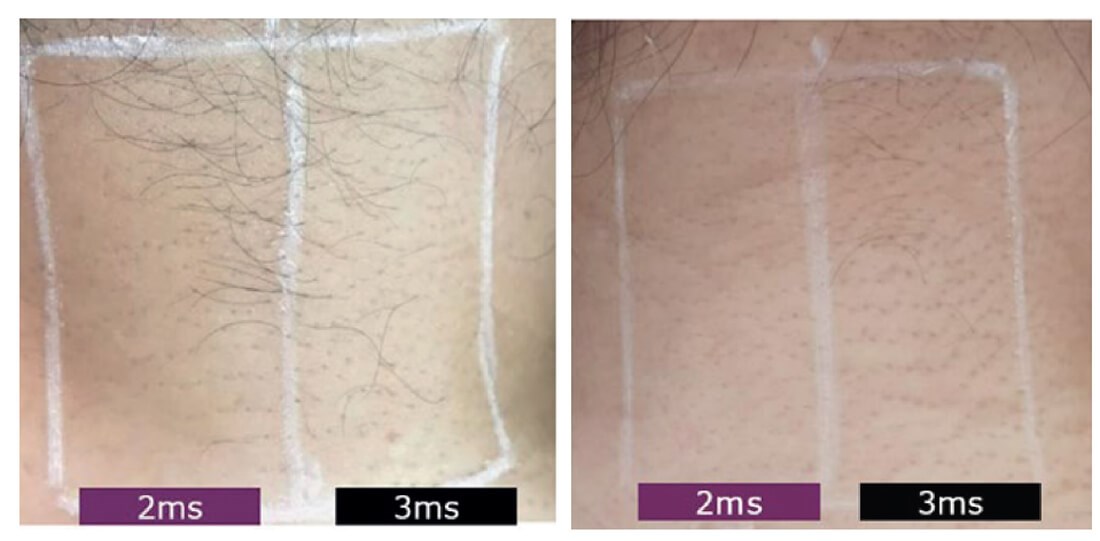
Abstract: This study evaluates the effectiveness of 2 ms versus 3 ms pulse duration in laser hair removal (LHR) with the GentleMax Pro Plus™ system using a 755 nm Alexandrite handpiece in subjects with Fitzpatrick skin types III and IV. A total of 20 subjects with various treatments at different body locations had participated in the study. Each subject received two treatments six weeks apart, with follow-up sessions conducted at one and five months after the second treatment. Results demonstrated that hair reduction using 2 ms pulse duration was 5% and 9% greater than 3 ms pulse duration at one- and five-month follow‑up post-second treatment.
Keywords: laser hair removal, pulse duration, GentleMax Pro Plus™, hair reduction, fine hair, Fitzpatrick skin types
Introduction
Lasers’ established safety, efficacy, and cost-efficiency make laser hair removal (LHR) synonymous with permanent hair reduction.
LHR advantages stem from the theory of selective photothermolysis [1] and laser parameter scalability, including wavelength, spot size, fluence, pulse duration, and epidermal protection. Selective photothermolysis suggests specific light wavelengths can safely target chromophores in the skin, such as melanin for hair removal, without damaging surrounding tissue. Modifying laser parameters can result in significantly different outcomes.
Leading laser experts [2] have proposed shorter pulse durations are necessary for treating thinner, finer hairs. However, no research has been conducted on the efficacy of hair removal with pulses shorter than 3 ms, delivered with a stamping technique at repetition rates up to 2 Hz.
This report investigates the efficacy of 2 ms versus 3 ms pulse widths in hair removal using Candela’s GentleMax Pro Plus™ system, which features higher fluences, larger spot sizes and shorter pulse durations for increased treatment speed and greater patient comfort. LHR treatments were performed on subjects with Fitzpatrick skin types III and IV using 2 ms pulse duration on 50% of their treatment locations and 3 ms on the other 50% to demonstrate the effectiveness of 2 ms over 3 ms, in alignment with existing literature [3].
Methodology
Subjects received two LHR treatments six weeks apart with a 755 nm laser, with follow-ups conducted at one and five months after the second treatment. Each subject’s treatment location was divided by two, with 50% receiving treatment with a 2 ms pulse duration and 50% receiving treatment with a 3 ms pulse. Subjects were treated on one of the following locations: face, jawline, upper back, back of the neck, full bikini, hand, arm, or thigh. The provider determined treatment parameters and Table 1 demonstrates mean treatment parameters used during both treatments. To ensure a valid comparison between treatment sessions, parameters including repetition rate, spot size, pulse duration, and fluence were held constant with best effort, allowing pulse duration to be the sole differentiating factor.

Hair count data was collected at baseline (pre-treatment one) and at both follow-ups, executed by two clinical representatives counting twice at the same treatment location. An average was taken as the final count.
Patient feedback on pain levels was also collected using a scoring system scale of 0 to 10 (0 = no pain, 10 = worst pain). A qualitative survey was used by subjects to report satisfaction.
Table 1 presents an overview of the treatment parameters using 755 nm Alexandrite laser handpiece.
Results
Demographics
A total of 20 subjects (two males, 18 females) participated in this study with a mean age of 31.45 (SD +5.19) and Fitzpatrick skin types III (90%) and IV (10%). 18 subjects (90%) completed all study visits.
Efficacy Results
Percentage hair reduction seen at one-month follow-up with 2 ms and 3 ms was 50% and 45% respectively. At five-month follow-up, percentage reduction was 38% and 29% respectively. This demonstrates percentage hair reduction with 2 ms pulse duration was 5% and 9% more than 3 ms pulse duration at one-month and five-month follow-ups, respectively (See Figure 1).

Figure 1: The baseline photo (back of neck) and five-month follow up photo after two treatment sessions.
Photo Courtesy of Medilase. Photos are unretouched. Individual results may vary.
Table 2 displays all treated subjects’ mean hair count numbers and reduction percentages.

Patient feedback on pain tolerance for 2 ms pulse duration (M=3.65, SD=2.09) was on par or similar to the 3 ms pulse duration (M=3.6, SD=1.91, Range: 0-10 (min: 0, max: 10)), indicating shortening the pulse duration has not significantly impacted patient tolerance. Furthermore, there were no complications with treatment and no device-related or non-device-related adverse events. In addition, all subjects were highly satisfied with the treatment using 2 ms pulse duration.
Discussion
Our findings align with the existing findings [3] demonstrating that a 2 ms pulse duration can yield improved LHR clinical outcomes for fine hair reduction compared to a 3 ms pulse duration, especially in subjects with Fitzpatrick skin types III and IV. This study expands on the previous study’s findings [3] with additional data from subjects providing further evidence in favour of using a 2 ms pulse duration.
Notably, the 5% and 9% greater hair reductions seen with the 2 ms pulse duration at one and five months after the second treatment, respectively, may significantly impact patient satisfaction and overall treatment outcomes as improved results may lead to fewer treatment sessions for desired hair reduction, translating into cost savings and increased convenience for patients and practitioners. In addition, the reported difference in pain scores between 2 ms and 3 ms appears to make a 2 ms pulse more comfortable for patients.
Results can be considered in the context of optimising LHR treatment parameters for various skin types and hair characteristics. Customising pulse duration based on individual needs could enhance LHR efficacy and safety, leading to better patient experiences and outcomes.
Study limitations include a relatively small sample size, lack of long-term follow-up data, and the absence of a control group. Future research could benefit from an increased number of treatment sessions, larger, more diverse study samples, more treatment sessions, and a longer follow-up period to assess the durability of effects. Additionally, investigating the impact of other treatment parameters on hair reduction outcomes, such as fluence and spot size, could further refine LHR techniques.
Conclusion
This study demonstrates the GentleMax Pro Plus™ system’s 2 ms pulse duration has the potential to achieve improved outcomes in fine hair removal without adverse events for subjects with Fitzpatrick skin types III and IV. The 2 ms pulse duration showed a 9% greater hair reduction than the 3 ms pulse duration after five months, supporting the hypothesis that 2 ms pulse duration can enhance LHR clinical outcomes. This study’s results can guide treatment parameter optimisation and customisation to improve LHR patient experiences and outcomes.
References
1. Anderson, R. R., & Parish, J. A. (1983). Selective photothermolysis: Precise microsurgery by selective absorption of pulsed radiation. Science, 226(4672), 524‑527.
2. Candela Corporation. (2003). The value of pulse duration and peak power in laser hair removal and related applications: A roundtable discussion of leading laser experts (Clinical Paper No. 2).Schallen, K. P. (2021). Improved laser hair removal (LHR) efficacy using 2 ms vs 3 ms pulse widths. Clinical Bulletin.
Accessed at https://assets.mediafly.com/l/C5BctCbxKx2j.
3. Schallen, K. P. (2021). Improved laser hair removal (LHR) efficacy using 2 ms vs 3 ms pulse widths. Clinical Bulletin.
Accessed at https://assets.mediafly.com/l/C5BctCbxKx2j
The author would like to acknowledge Senior Vice President and Medical Director Dr. Konika Patel Schallen for providing medical expertise to this report. The author also acknowledges support from Candela Clinical Research and Affairs Team and Program Engineering team for their assistance, thorough review, and feedback.
Key Takeaways
-
The study found that a 2 ms pulse duration treatment showed a 5% greater hair reduction after one month and a 9% greater hair reduction after five months compared to the 3 ms pulse duration treatment, supporting the hypothesis that the 2 ms pulse duration can enhance LHR clinical outcomes for fine hair removal with on‑par patient feedback on pain tolerance, both obtaining a median of 3.6 out of 10.
-
Customising pulse duration based on individual needs could enhance LHR efficacy and safety, leading to better patient experiences and outcomes. This study’s results contribute to a better understanding of treatment parameter optimisation, which can help practitioners tailor LHR treatments to achieve optimal results for various skin types and hair characteristics.



